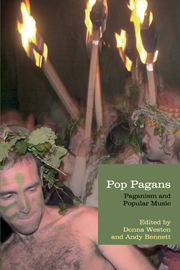Book contents
- Frontmatter
- Contents
- Contributors
- Foreword
- 1 Towards a definition of Pagan music
- Part I Histories
- 2 Paganism and the counter-culture
- 3 Paganism, popular music and Stonehenge
- 4 Rememberings of a Pagan past: popular music and sacred place
- Part II Genres
- Part III Performance
- Part IV Communities
- Bibliography
- Discography and filmography
- Index
3 - Paganism, popular music and Stonehenge
from Part I - Histories
- Frontmatter
- Contents
- Contributors
- Foreword
- 1 Towards a definition of Pagan music
- Part I Histories
- 2 Paganism and the counter-culture
- 3 Paganism, popular music and Stonehenge
- 4 Rememberings of a Pagan past: popular music and sacred place
- Part II Genres
- Part III Performance
- Part IV Communities
- Bibliography
- Discography and filmography
- Index
Summary
Places associated with ritual activity have a particular ability to connect individuals to each other and to the ecology of the local geography. This certainly seems to be the case at Stonehenge, a megalithic site that has a particular resonance within both popular music and Pagan traditions. For thousands of years, people have gathered at Stonehenge to watch the rising of the sun on the summer solstice or the setting of the sun on the winter solstice. The site is arranged to fit this solar alignment, and in recent years as many as 20,000 people have congregated at this ancient monument on the solstice, trying to connect with what they perceive as ancient Pagan traditions. Such congregations, as well as the many other traditions that have grown up around the site, have sacralized the space, turning it into a place that has complex meanings.
This chapter aims to explore the relationships between Stonehenge, popular music and Paganisms. It begins by exploring attitudes to physical and situated culture within Pagan and popular music cultures, and looking at how this has created oppositional dynamics with Christianity. This is followed by an exploration of how Stonehenge became associated with popular music in general, and rock music in particular. It investigates the field of Stonehenge, including its acoustic field, discussing the importance of sound in Stonehenge's ritual culture throughout history, helping it to become an iconic representation of Pagan spiritualities.
- Type
- Chapter
- Information
- Pop PagansPaganism and Popular Music, pp. 24 - 42Publisher: Acumen PublishingPrint publication year: 2013



